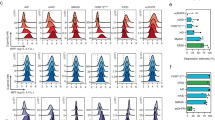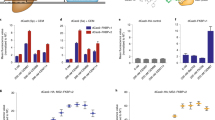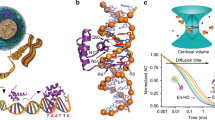Abstract
Artificial transcription factors containing designer zinc-finger DNA-binding domains (DBDs) have been used to activate or repress expression of a growing number of endogenous genes. We have combined targeted zinc-finger DBD technology with a dimerizer-regulated gene expression system to permit the small-molecule control of endogenous gene transcription. We constructed a dimerizer-responsive transcription factor that incorporates an artificial zinc-finger DBD targeted to the promoter of the human VEGF gene. Introduction of this activator into human cells allowed expression of the chromosomal VEGF gene to be induced by a small-molecule dimerizer compound consisting of a nonimmunosuppressive rapamycin analog. We found that by directly regulating zinc-finger protein (ZFP) activity, we could circumvent difficulties encountered in the generation of cell lines stably expressing conventional unregulated activators. Dimerizer-dependent VEGF induction was rapid, tight, and dose dependent, and resulted in VEGF protein expression levels several-fold greater than those produced by the natural hypoxic response.
This is a preview of subscription content, access via your institution
Access options
Subscribe to this journal
Receive 12 print issues and online access
$209.00 per year
only $17.42 per issue
Buy this article
- Purchase on Springer Link
- Instant access to full article PDF
Prices may be subject to local taxes which are calculated during checkout





Similar content being viewed by others
References
Wolfe, S.A., Nekludova, L. & Pabo, C.O. DNA recognition by Cys2His2 zinc finger proteins. Annu. Rev. Biophys. Biomol. Struct. 29, 183–212 (2000).
Pabo, C.O., Peisach, E. & Grant, R.A. Design and selection of novel Cys2His2 zinc finger proteins. Annu. Rev. Biochem. 70, 313–340 (2001).
Beerli, R.R. & Barbas, C.F. Engineering polydactyl zinc-finger transcription factors. Nat. Biotechnol. 20, 135–141 (2002).
Beerli, R.R., Dreier, B. & Barbas, C.F. Positive and negative regulation of endogenous genes by designed transcription factors. Proc. Natl. Acad. Sci. USA 97, 1495–1500 (2000).
Zhang, L. et al. Synthetic zinc finger transcription factor action at an endogenous chromosomal site. J. Biol. Chem. 275, 33850–33860 (2000).
Bartsevich, V.V. & Juliano, R.L. Regulation of the MDR1 gene by transcriptional repressors selected using peptide combinatorial libraries. Mol. Pharmacol. 58, 1–10 (2000).
Liu, P.Q. et al. Regulation of an endogenous locus using a panel of designed zinc finger proteins targeted to accessible chromatin regions. J. Biol. Chem. 276, 11323–11334 (2001).
Dreier, B., Beerli, R.R., Segal, D.J., Flippin, J.D. & Barbas, C.F. Development of zinc finger domains for recognition of the 5′-ANN-3′ family of DNA sequences and their use in the construction of artificial transcription factors. J. Biol. Chem. 276, 29466–29478 (2001).
Gossen, M. & Bujard, H. Tight control of gene expression in mammalian cells by tetracycline-responsive promoters. Proc. Natl. Acad. Sci. USA 89, 5547–5551 (1992).
Wang, Y., O'Malley, B.W. Jr., Tsai, S.Y. & O'Malley, B.W. A regulatory system for use in gene transfer. Proc. Natl. Acad. Sci. USA 91, 8180–8184 (1994).
No, D., Yao, T.P. & Evans, R.M. Ecdysone-inducible gene expression in mammalian cells and transgenic mice. Proc. Natl. Acad. Sci. USA 93, 3346–3351 (1996).
Beerli, R.R., Schopfer, U., Dreier, B. & Barbas, C.F. Chemically regulated zinc finger transcription factors. J. Biol. Chem. 275, 32617–32627 (2000).
Xu, L. et al. A versatile framework for the design of ligand-dependent, transgene-specific transcription factors. Mol. Ther. 3, 262–273 (2001).
Rivera, V.M. et al. A humanized system for pharmacologic control of gene expression. Nat. Med. 2, 1028–1032 (1996).
Ho, S.N., Biggar, S.R., Spencer, D.M., Schreiber, S.L. & Crabtree, G.R. Dimeric ligands define a role for transcriptional activation domains in reinitiation. Nature 382, 822–826 (1996).
Pollock, R. et al. Delivery of a stringent dimerizer-regulated gene expression system in a single retroviral vector. Proc. Natl. Acad. Sci. USA 97, 13221–13226 (2000).
Pomerantz, J.L., Sharp, P.A. & Pabo, C.O. Structure-based design of transcription factors. Science 267, 93–96 (1995).
Berger, S.L. et al. Genetic isolation of ADA2: a potential transcriptional adaptor required for function of certain acidic activation domains. Cell 70, 251–265 (1992).
Gilbert, D.M., Heery, D.M., Losson, R., Chambon, P. & Lemoine, Y. Estradiol-inducible squelching and cell growth arrest by a chimeric VP16-estrogen receptor expressed in Saccharomyces cerevisiae: suppression by an allele of PDR1. Mol. Cell Biol. 13, 462–472 (1993).
Shockett, P., Difilippantonio, M., Hellman, N. & Schatz, D.G. A modified tetracycline-regulated system provides autoregulatory, inducible gene expression in cultured cells and transgenic mice. Proc. Natl. Acad. Sci. USA 92, 6522–6526 (1995).
Baron, U., Gossen, M. & Bujard, H. Tetracycline-controlled transcription in eukaryotes: novel transactivators with graded transactivation potential. Nucleic Acids Res. 25, 2723–2729 (1997).
Molinari, E., Gilman, M. & Natesan, S. Proteasome-mediated degradation of transcriptional activators correlates with activation domain potency in vivo. EMBO J. 18, 6439–6447 (1999).
Salghetti, S.E., Muratani, M., Wijnen, H., Futcher, B. & Tansey, W.P. Functional overlap of sequences that activate transcription and signal ubiquitin-mediated proteolysis. Proc. Natl. Acad. Sci. USA 97, 3118–3123 (2000).
Guyer, D. et al. Activation of latent transgenes in Arabidopsis using a hybrid transcription factor. Genetics 149, 633–639 (1998).
Brand, A.H. & Perrimon, N. Targeted gene expression as a means of altering cell fates and generating dominant phenotypes. Development 118, 401–415 (1993).
Carmeliet, P. VEGF gene therapy: stimulating angiogenesis or angioma-genesis? Nat. Med. 6, 1102–1103 (2000).
Greisman, H.A. & Pabo, C.O. A general strategy for selecting high-affinity zinc finger proteins for diverse DNA target sites. Science 275, 657–661 (1997).
Kim, J.S. & Pabo, C.O. Getting a handhold on DNA: design of poly-zinc finger proteins with femtomolar dissociation constants. Proc. Natl. Acad. Sci. USA 95, 2812–2817 (1998).
Moore, M., Klug, A. & Choo, Y., Improved DNA-binding specificity from polyzinc finger peptides by using strings of two-finger units. Proc. Natl. Acad. Sci. USA 98, 1437–1441 (2001).
Vincent, K.A. et al. Angiogenesis is induced in a rabbit model of hindlimb ischemia by naked DNA encoding an HIF-1α/VP16 hybrid transcription factor. Circulation 102, 2255–2261 (2000).
Acknowledgements
We thank Vic Rivera for helpful comments on the manuscript.
Author information
Authors and Affiliations
Corresponding author
Ethics declarations
Competing interests
R.P., K.L., and T.C. are employed by and own equity in ARIAD Pharmaceuticals, Inc.
Rights and permissions
About this article
Cite this article
Pollock, R., Giel, M., Linher, K. et al. Regulation of endogenous gene expression with a small-molecule dimerizer. Nat Biotechnol 20, 729–733 (2002). https://doi.org/10.1038/nbt0702-729
Received:
Accepted:
Issue Date:
DOI: https://doi.org/10.1038/nbt0702-729
This article is cited by
-
Regulation of CCR7-dependent cell migration through CCR7 homodimer formation
Scientific Reports (2017)
-
Distinct roles of RIP1–RIP3 hetero- and RIP3–RIP3 homo-interaction in mediating necroptosis
Cell Death & Differentiation (2014)
-
Zinc Finger Nucleases as tools to understand and treat human diseases
BMC Medicine (2010)
-
Characterization of a molecular switch system that regulates gene expression in mammalian cells through a small molecule
BMC Biotechnology (2010)
-
Drug-inducible and simultaneous regulation of endogenous genes by single-chain nuclear receptor-based zinc-finger transcription factor gene switches
Gene Therapy (2008)



